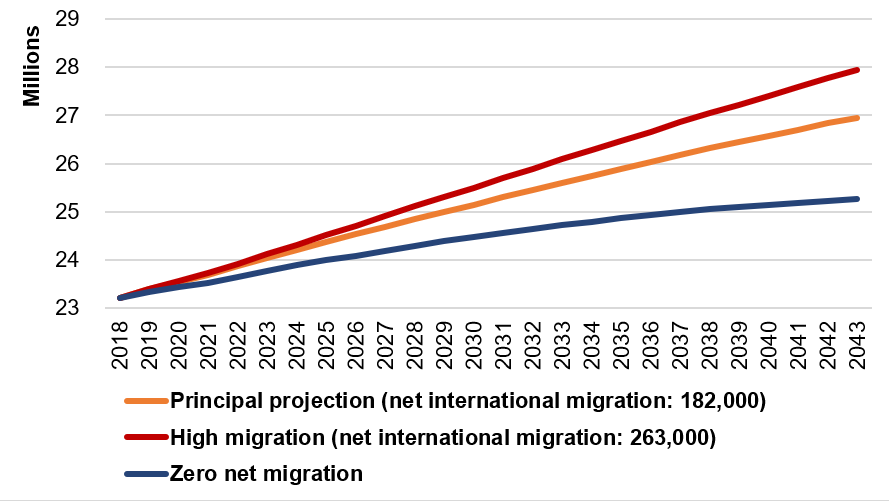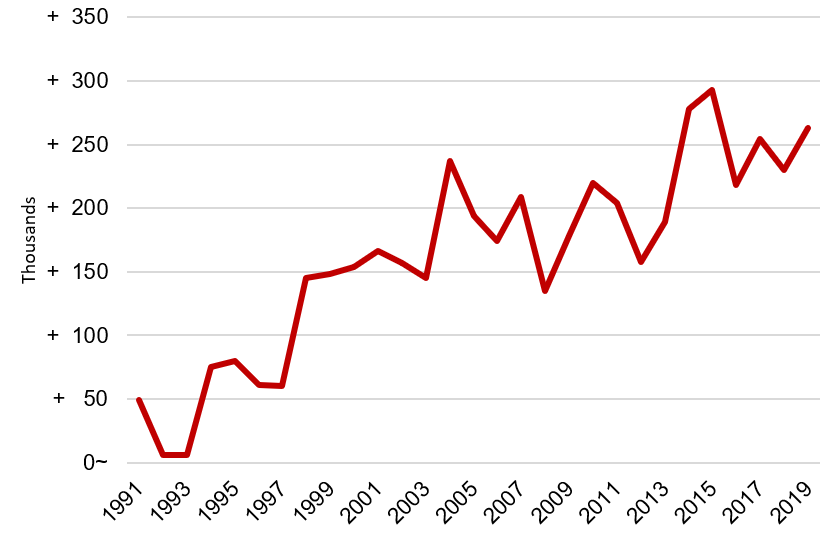Summary
1. After the Covid crisis, net migration levels could well revert to the high levels witnessed over the past five years, or even surpass them, given the range of additional uncapped routes being opened under the new Points Based System. If so, just over half of extra homes needed in England by the early 2040s will be a result of immigration. This would require a new home every five minutes, or nearly 300 every day.
Introduction
2. Household projections are produced every two years on the basis of the Annual Population Survey (APS) published two years previously. This year’s 2018-based projections were published during June 2020. Normally they contain a range of scenarios – zero net migration, a principal projection and a high migration scenario.
3. The original publication of the projections did not, however, include a zero migration scenario. This is important as it allows an estimate of the impact of immigration on the growth in the number of households. It has now been published in response to a request from Migration Watch UK and is included in the analysis below.
4. We compare the following ONS variants[i] (as illustrated by Figure 1 below):
- The ‘zero migration’ scenario shows what is expected to happen to demand for homes in England in the absence of overseas net migration. Under this, the number of households in England increases from 23.2 million in 2018 to 25.3 million in 2043 – a rise of just over 2 million.[ii]
- A ‘principal projection’ (based on net migration to England of 182,000 per year) estimates that the number of households will increase from 23.2 million in 2018 to just under 27 million in 2043 – a rise of 3.7 million.
- The so-called ‘high migration scenario’, with overseas net migration to England set at 263,000 per year [NB this was the actual level of overseas net migration to England in 2019]. This would see the number of households increase from 23.3 million in 2018 to 27.9 million in 2043 – a rise of 4.7 million.
Figure 1: Variants in the 2018-based ONS household projections, 2018-2043.

5. It is important to note that the level of net migration to England stood at 263,000 in 2019, according to recently released ONS figures (see Figure 2 below). It has also averaged just under 260,000 since 2014 – close to the so-called “high migration” scenario of 263,000.
Figure 2: Overseas net migration to England, 1991 to 2019, ONS statistics.

6. Accordingly, it is appropriate to look at the so-called ‘high migration’ scenario to see how recent levels of immigration could impact housing demand should they be allowed to continue, or even surpass this, after the pandemic.
7. Given the loosening of requirements for work permits and post-study work visas, alongside the introduction of a new route to citizenship for people from Hong Kong, a reversion to very high net migration after the pandemic seems plausible and indeed likely. Ongoing high immigration could be further compounded by ongoing illegal entries from northern Europe (over 90% of whom go on to claim asylum) and the major decay in immigration enforcement that has been documented by the National Audit Office, the Independent Chief Inspector of Borders and the House of Commons Public Accounts Committee.
8. A comparison of the zero and high migration scenarios summarised in paragraph 4 above points to a difference of 2.69 million homes over a 25-year period (2018-2043). This is the number of homes that will be required solely as the result of immigration if it recovers to the near-record level we witnessed just before Covid struck. Immigration alone accounts for 57% of additional homes projected to be needed under the ‘high migration’ scenario – or 2.7 million of 4.7 million. So at the level that immigration reached in 2019 (263,000), it would account for just over half of the homes needed.
9. Should immigration run at that level over 25 years, it would amount to the need to make available 107,400 more homes per year over 25 years, or 294 per day out of the 519 per day that would need to be built overall (107,000 out of 189,000 per year). Another home would be needed every five minutes to accommodate the 2019 level of immigration.
10. It is also worth noting that, even if overseas net migration to England was to fall to around the ONS ‘principal projection’- 182,000 per year (it was only just above this at 189,000 in 2013), it would still account for nearly half (45%, or 1.7 million of a total of 3.7 million more homes needed) of additional homes required. However, figure 2 above indicates that overseas net migration to England did not run at less than 200,000 during the period 2014-2019.
